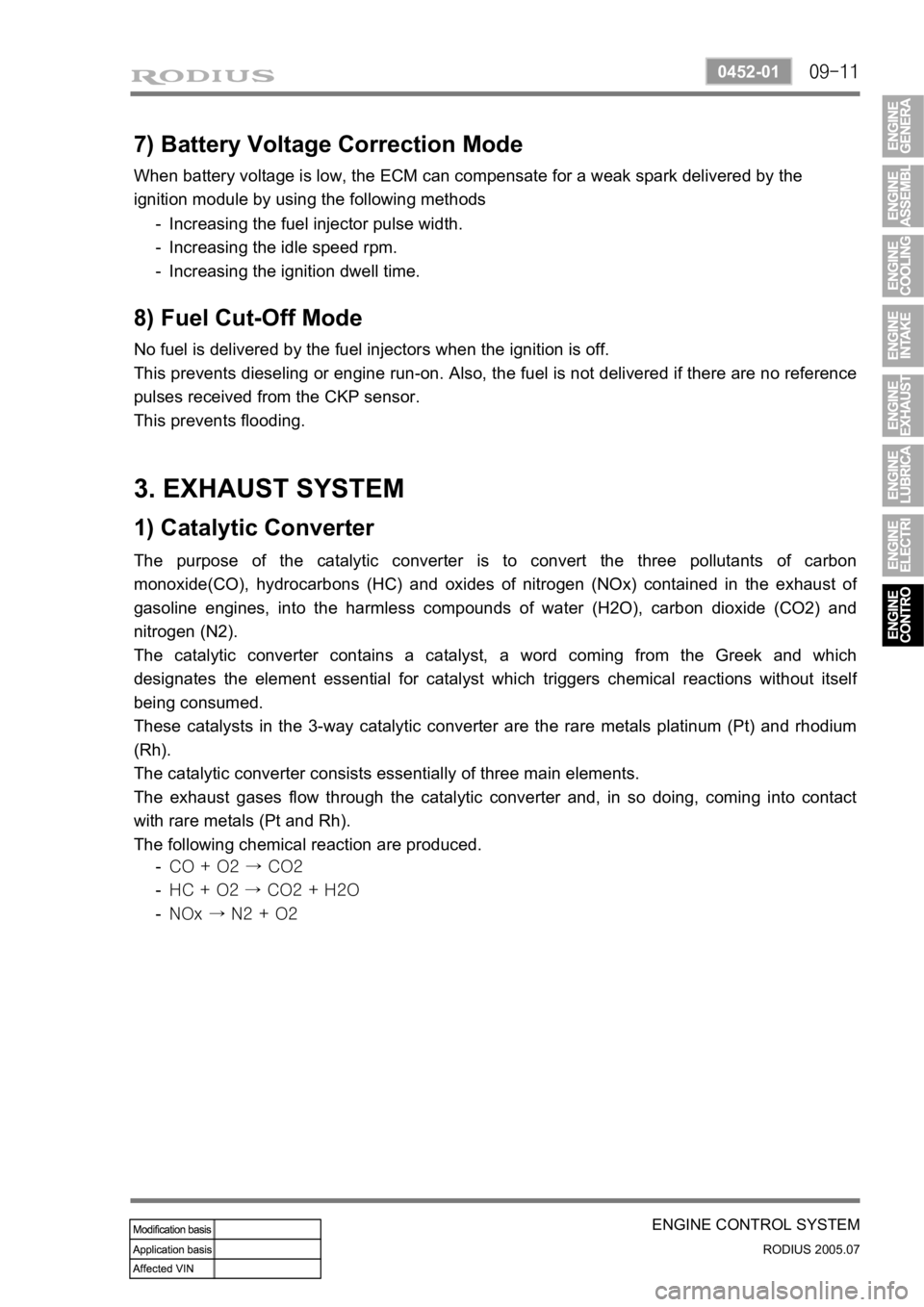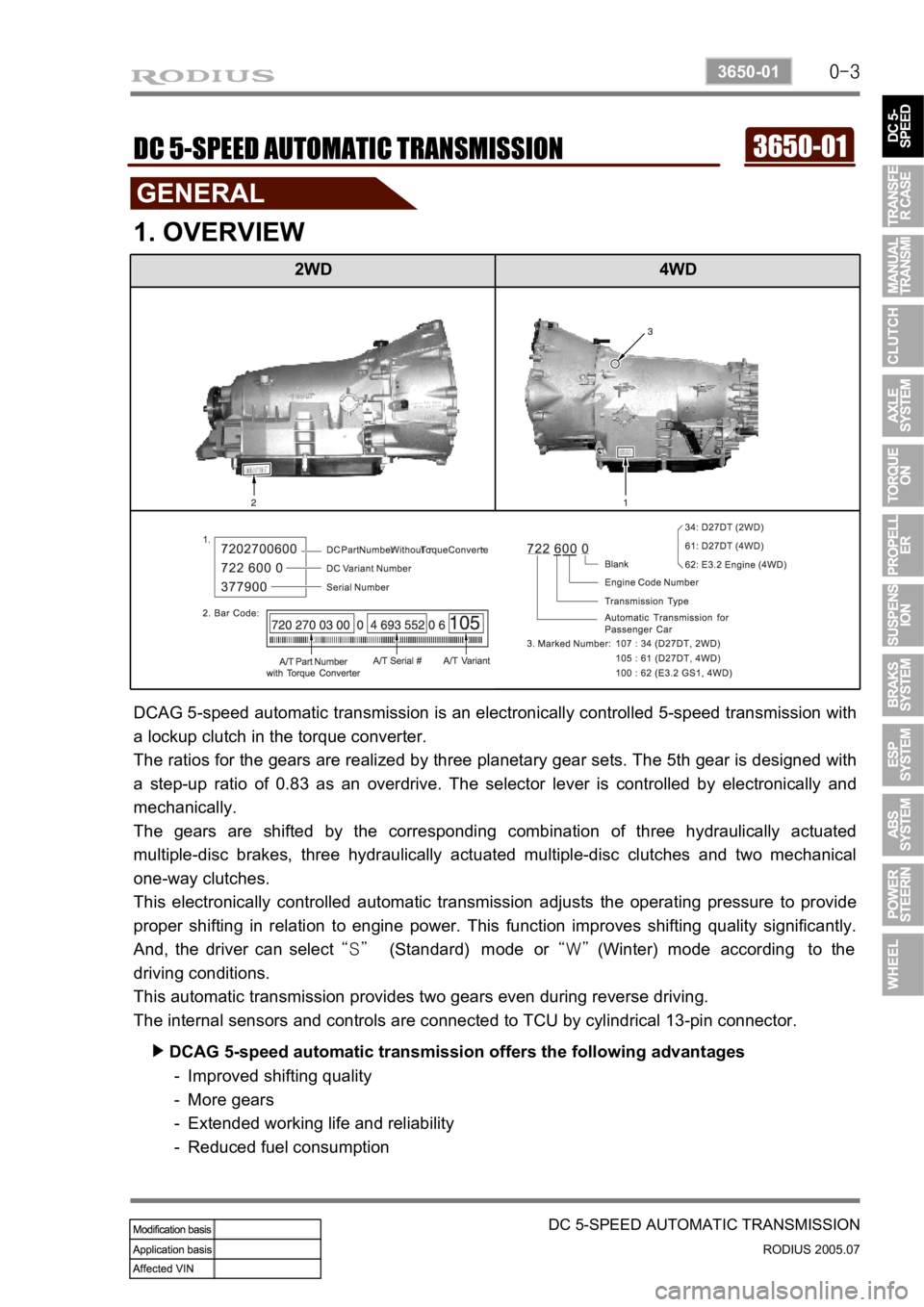Page 157 of 502

09-11
ENGINE CONTROL SYSTEM
RODIUS 2005.07
0452-01
No fuel is delivered by the fuel injectors when the ignition is off.
This prevents dieseling or engine run-on. Also, the fuel is not delivered if there are no reference
pulses received from the CKP sensor.
This prevents flooding.
8) Fuel Cut-Off Mode
Increasing the fuel injector pulse width.
Increasing the idle speed rpm.
Increasing the ignition dwell time. -
-
- When battery voltage is low, the ECM can compensate for a weak spark delivered by the
ignition module by using the following methods
7) Battery Voltage Correction Mode
3. EXHAUST SYSTEM
1) Catalytic Converter
The purpose of the catalytic converter is to convert the three pollutants of carbon
monoxide(CO), hydrocarbons (HC) and oxides of nitrogen (NOx) contained in the exhaust o
f
gasoline engines, into the harmless compounds of water (H2O), carbon dioxide (CO2) and
nitrogen (N2).
The catalytic converter contains a catalyst, a word coming from the Greek and which
designates the element essential for catalyst which triggers chemical reactions without itsel
f
being consumed.
These catalysts in the 3-way catalytic converter are the rare metals platinum (Pt) and rhodium
(Rh).
The catalytic converter consists essentially of three main elements.
The exhaust gases flow through the catalytic converter and, in so doing, coming into contact
with rare metals (Pt and Rh).
The following chemical reaction are produced.
CO + O2 → CO2
HC + O2 → CO2 + H2O
NOx → N2 + O2 -
-
-
Page 158 of 502

09-12
RODIUS 2005.07
0452-01
ENGINE CONTROL SYSTEM
Ignition “OFF” ▶
4. INDUCTION SYSTEM
1) Throttle Valve Actuator
The throttle actuator is actuated by the Engine Control Module(ECM) according to the position
of the accelerator pedal position.
It has two potentiometers which signal the position of the throttle valve to the ECM to enable it
to recognize the various engine load states.
In the de-energized states the throttle valve position is determined to be spring capsule.
Ignition “ON” ▶
When the ignition S/W on the servo motor in the throttle actuator is operated by the ECM.
The throttle valve adopts a position in line with the coolant temperature.
In the closed throttle position, the servo motor controls engine speed by operating the throttle
valve further (greater mixture) or closing it further (reduced mixture), depending on coolant
temperature and engine load.
When this is done, the throttle valve can be closed further by the servo motor overcoming the
force of the spring capsule (mechanical end stop).
If the actuator is deenergized, the throttle valve is resting against the spring capsule.
Consequently, the throttle valve opening is a constant 10 ~ 12° approximately.
At no load, this produces an engine speed of about 1,800 rpmClosed Position ▶
Page 159 of 502
09-13
ENGINE CONTROL SYSTEM
RODIUS 2005.07
0452-01
When driving (part/full throttle), the servo motor controls the throttle valve in line with the
various load states and according to the input signals from the pedal value sensor according to
the input signals from the pedal value sensor according to the position of the accelerator pedal.
The function of the EA (electronic accelerator) in the ECM determines the opening angle of the
throttle valve through the throttle actuator.
Further functions areDriving ▶
Idle speed control
Cruise control
Reducing engine torque for ASR/ABS
operation
Electronic accelerator emergency running
Storing faults
Data transfer through CAN -
-
-
-
-
-
-
Page 160 of 502
09-14
RODIUS 2005.07
0452-01
ENGINE CONTROL SYSTEM
1) Diagnosis Circuit
5. SCHEMATIC AND ROUTING
DIAGRAMS
Page 161 of 502
09-15
ENGINE CONTROL SYSTEM
RODIUS 2005.07
0452-01
2) ECU (GSL G32)
IGN COIL, CPS, AIR FLOW SENSOR, THROTTLE SENSOR, TPS ▶
Page 162 of 502
09-16
RODIUS 2005.07
0452-01
ENGINE CONTROL SYSTEM
O2 SENSOR, PEDAL MODULE, CRUISE CONTROL SW, STOP LAMP SW ▶
Page 163 of 502
09-17
ENGINE CONTROL SYSTEM
RODIUS 2005.07
0452-01
INJECTOR, KNOCK SENSOR, IMMOBILIZER, CANISTER PURGE VALVE ▶
Page 164 of 502

0-3
DC 5-SPEED AUTOMATIC TRANSMISSION
RODIUS 2005.07
3650-01
2WD 4WD
3650-01DC 5-SPEED AUTOMATIC TRANSMISSION
1. OVERVIEW
DCAG 5-speed automatic transmission is an electronically controlled 5-speed transmission with
a lockup clutch in the torque converter.
The ratios for the gears are realized by three planetary gear sets. The 5th gear is designed with
a step-up ratio of 0.83 as an overdrive. The selector lever is controlled by electronically and
mechanically.
The gears are shifted by the corresponding combination of three hydraulically actuated
multiple-disc brakes, three hydraulically actuated multiple-disc clutches and two mechanical
one-way clutches.
This electronically controlled automatic transmission adjusts the operating pressure to provide
proper shifting in relation to engine power. This function improves shifting quality significantly.
And, the driver can select “S” (Standard) mode or “W” (Winter) mode according to the
driving conditions.
This automatic transmission provides two gears even during reverse driving.
The internal sensors and controls are connected to TCU by cylindrical 13-pin connector.
DCAG 5-speed automatic transmission offers the following advantages ▶
Improved shifting quality
More gears
Extended working life and reliability
Reduced fuel consumption -
-
-
-